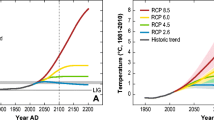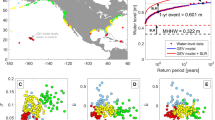Abstract
Globally, sea level has been rising for more than the last one hundred years, and is expected to do so into the foreseeable future, and at an accelerating rate. The direct influences of sea-level rise on water resources come principally from the following: new or accelerated coastal erosion; more extensive coastal inundation and higher levels of sea flooding; increases in the landward reach of sea waves and storm surges; seawater intrusion into surface waters and coastal aquifers; and further encroachment of tidal waters into estuaries and coastal river systems. The impacts of sea-level rise are likely to be felt disproportionately in certain areas, reflecting both natural and socio-economic factors that enhance the levels of risks. The opportunity to learn about the likely nature of, and most appropriate adaptation to, the anticipated impacts of sea-level rise on water resources is arguably best developed in rapidly subsiding coastal areas, and especially in low-lying deltas where subsidence rates are typically much larger than the historic rise in global mean sea level. Significantly, such areas are often major centres of population and of economic activity, thereby highlighting the human dimensions of sea-level rise. Sound management of the risks to water resources associated with sea-level rise requires enhancing adaptive capacity, mainstreaming adaptation, harmonizing responses to extreme events, variability and long-term change and strengthening regional and international cooperation and coordination. In this regard, the policies and initiatives of international organisations are not always entirely consistent with the needs of developing countries.
Similar content being viewed by others
References
Alam, M.: 1996, ‘,Subsidence of the Ganges–Brahmaputra Delta of Bangladesh and associated drainage, sedimentation and salinity problems’, in J.D. Milliman and B.U. Haq (eds.), Sea-level Rise and Coastal Subsidence: Causes, Consequences and Strategies, Kluwer, Dordrecht, pp.169–192.
Bergkamp, G., Orlando, B. and Burton, I.: 2003, Change: Adaptation of Water Resources Management to Climate Change. The World Conservation Union, Cambridge, p. 53
Ellison, J.C.: 1992, ‘,Impacts of sea level rise on Pacific Island mangrove swamps’, in J. O'Callahan, (ed.), Proceedings of the IPCC Workshop Held at Margarita Island, Venezuela, March 1992. Silver Spring, MD (USA): National Oceanic and Atmospheric Administration, pp. 641–657.
Emery, K.O. and Aubrey, D.G.: 1991, Sea Levels, Land Levels and Tide Gauges. Springer-Verlag, New York, p. 237.
Folke, C., Colding, J. and Berkes, F.: 2002a, ‘,Building resilience for adaptive capacity in social-ecological systems’, in F. Berkes, J. Colding and C. Folke (eds.), Navigating Social-Eclogical Systems: Building Resilience for Complexity and Change, Cambridge University Press, Cambridge.
Folke, C. and 24 co-authors, 2002b: Resilience and Sustainable Development: Building Adaptive Capacity in a World of Transformations, Scientific Background Paper on Resilience for the Process of the World Summit on Sustainable Development, on Behalf of the Environmental Advisory Council to the Swedish Government, April 2002, p. 33.
Ho, G. (ed.): 2002, International Source Book on Environmentally Sound Technologies for Wastewater and Stormwater Management, Technical Publication 15, International Environmental Technology Centre, United Nations Environment Programme, Osaka, Japan.
Hoozemans, F.M.J., Marchand, M., Pennekamp, H., Stive, M., Misdorp, R. and Bijlsma, L.: 1992, ‘,The impacts of sea level rise on coastal areas: Some global results’, in O'Callahan, Joan (ed.), Global Environmental Change and the Rising Challenge of the Sea, Proceedings of the IPCC workshop held at Margarita Island, Venezuela, March 1992, Silver Spring, MD (USA), National Oceanic and Atmospheric Administration, pp. 607–622.
IPCC: 2001a, Climate Change 2001: The Scientific Basis, Contribution of Working Group I to the Third Assessment Report of the Intergovernmental Panel on Climate Change (IPCC), Cambridge University Press, Cambridge, UK. p. 881.
IPCC: 2001b, Climate Change 2001: Impacts, Adaptation and Vulnerability, Contribution of Working Group II to the Third Assessment Report of the Intergovernmental Panel on Climate Change (IPCC), Cambridge University Press, Cambridge, UK, p. 1032.
Kabat, P. and van Schaik, H.: 2002, Climate Changes the Water Rules, Dialogue on Water and Climate, Delft, The Netherlands, p. 106.
Kobayashi, H.: 2004, Impact evaluation of sea level rise on Indonesian coastal cities – Micro approach through field survey and macro approach through satellite image analysis. Journal of Global Environment Engineering 10, 77–91.
Mimura, N., 2000a: ‘,Distribution of vulnerability and adaptation in the Asia and Pacific Region’, in N. Mimura and H. Yokoki (eds.), Global Change and Asia Pacific Coasts, Proceedings of APN/SURVAS/LOICZ Joint Conference on Coastal Impacts of Climate Change and Adaptation in the Asia-Pacific Region, Kobe, Japan, November 2000, Asia Pacific Network for Global Change Research and Center for Water Environment Studies, Ibaraki University, Japan, pp. 21–25.
Mimura, N.: 2000b (ed.), ‘,Climate Change Impacts and Responses’, Proceedings of the Conference on National Assessment Results of Climate Change, San Jose, Costa Rica, March, 1998. Japan Environment Agency and Overseas Environmental Cooperation Center, Tokyo, Japan, p.~751.
Mimura, N. and Kawaguci. E.: 1996, ‘,Responses of coastal topography to sea-level rise’, Coastal Engineering 2, 1349–1360.
Miyagi, T., Charlchai, T., Pramojanee, P., Fujimoto, K. and Mochida, Y.: 1999, Mangrove Habitat Dynamics and Sea-level Change – A Scenario and GIS Mapping of the Changing Process of the Delta and Estuary Type Mangrove Habitat in Southwestern Thailand, TROPICS 8–3, pp. 179–196.
Moshin-Uddin, Md. and S. Islam: 1982, ‘,Polder development in Bangladesh Paper I: Past and present development’, in Polders of the World, International Institute for Land Reclamation, The Netherlands, pp. 288–295.
Nicholls, R.J.: 2002, Climate Change and Coastal Zones, Oral Evidence to International Development Committee: Climate Change and Sustainable Development, 29th January 2002, p.~5.
Nicholls, R.J. and Mimura, N.: 1998, ‘,Regional issues raised by sea-level rise and their policy implications’, Climate Research 11, 5–18.
Nutalaya, P., Yong, R.N., Thongchai Chumnankit and Somkid Buapeng: 1996, ‘,Land Subsidence in Bangkok during 1978–1988' in O'Callahan, Joan (ed.), Global Environmental Change and the Rising Challenge of the Sea. Proceedings of the IPCC workshop held at Margarita Island, Venezuela, March 1992. Silver Spring, MD (USA): National Oceanic and Atmospheric Administration, pp. 105–130.
Research Team of China Climate Change Country Study: 1999, China Climate Change Country Study, Tsinghua University Press, Beijing, China, p. 328.
Sphocleous, M.: 2004: Climate change: Why should water professionals care? Ground Water 42, p. 637.
UNEP: 1998, in J.F. Feenstra, I. Burton, J.B. Smith and R.S.J. Tol (eds.), Handbook on Methods for Climate Change Impact Assessment and Adaptation Strategies, United Nations Environment Programme, Institute for Environmental Studies, Amsterdam, The Netherlands, p. 359.
Author information
Authors and Affiliations
Corresponding author
Rights and permissions
About this article
Cite this article
Hay, J.E., Mimura, N. Sea-Level Rise: Implications for Water Resources Management. Mitig Adapt Strat Glob Change 10, 717–737 (2005). https://doi.org/10.1007/s11027-005-7305-5
Received:
Accepted:
Issue Date:
DOI: https://doi.org/10.1007/s11027-005-7305-5




